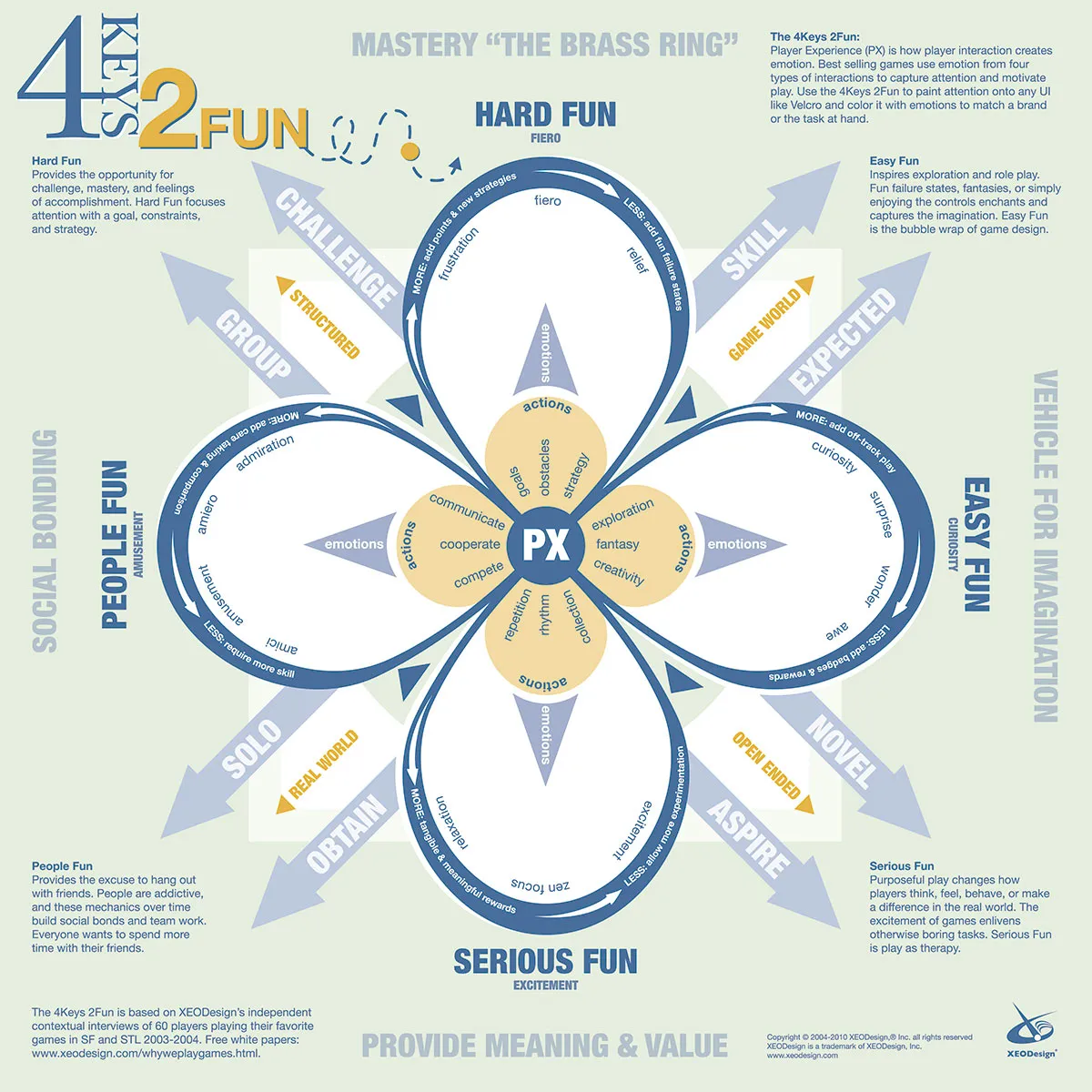Learning game development/Gamification
Seven Steps of Gamification
STEP 1
Choose a primary emotion
STEP 2
Set a gamification goal
STEP 3
Choose a genre
(Genre directs the choice of gameplay & interaction)
STEP 4(double-directed arrow between STEP 5)
Set the gameplay
- Goal
- Rules
- Challenge
- Feedback
STEP 5
Set interaction model & social interaction mode
STEP 6(all pointed by STEP 4 & 5)
Choose a game space
STEP 7
Develop a game story
Step 1: Choose a primary emotion
James-Lange Theory of Emotion
- Happy
- Angry
- Sad
- Feared
- Disgust
- Surprised
Primary Emotions vs Social Emotions<-Left the first
STEP 2: Set a gamification goal
Nicole Lazzaro on the Four Keys to Fun in Virtual Reality

Bartle taxonomy of player types
With reference to the primary emotion you set, develop a gamification goal for each type of player to have fun through your gamification practice.
| TYPES OF PLAYER | TYPES OF FUN | |||
|---|---|---|---|---|
| Serious Fun: Provide meaning & value | Hard Fun: Master knowledge & challenge | Easy Fun: Drive creativity & imagination | People Fun: Build social bonding | |
| Fighter(Acting-Players) | ||||
| Achiever(Acting-Game World) | ||||
| Socializer(Interacting-Players) | ||||
STEP 3: Choose a genre
Choose a game genre that suits your game platform(s).
| PLATFORM | GENRE | |||||||
|---|---|---|---|---|---|---|---|---|
| Action | Adventure | Exploration | Puzzle | RPG | Simulation | Sports | Strategy | |
| Physical world | ||||||||
| Tabletop | ||||||||
| Quiz/Trivia | ||||||||
| Arcade | ||||||||
| Console | ||||||||
| Mobile | ||||||||
| Online | ||||||||
| PC | ||||||||
| AR/VR | ||||||||
| Alternate Reality | ||||||||
| Hologram |
Step 4a: Set the gameplay
With reference to the genre you set, choose at least one suitable game challenge.
| CHALLENGES | Upon the completion of the GBL, players should be able to… |
|---|---|
| Memory | Recall things they have seen or heard in the game. |
| Knowledge | Apply knowledge on factual information. |
| Conceptual Reasoning | Solve problems using reasoning skills and extrinsic knowledge in specific subject matter. |
| Formal Logic | Apply strategic thinking in any turn-based games. |
| Lateral Thinking | Solve problems using twisted reasoning skills, i.e. thinking without the box. |
| Economic | Accumulate resources, achieve balance in economy, or caring for living things. |
| Conflict | Beat others by opposing them directly through strategy, tactics, logistics or stealth. |
| Physical Coordination | Apply physical ability, most commonly hand-eye coordination. |
| Time Pressure | Accomplish something before someone else does. |
| Exploration | Use spatial awareness when moving into new areas, seeing new things and overcoming obstacles. |
| Pattern Recognition | Spot visible or audible patterns / patterns of change and behavior. |
Step 4b: Set the gameplay
Set a game goal, rules and feedback for each challenge you chose.
LEARNING
Intended LO
- Observable behavior
- Degree of attainment
- Conditions of attainment
GAME PLAYING
Gamified Learning
Step 4c: Set the gameplay
Set one rule for each function that meets criteria of good game rules.
| Rules | Functions of rules | C1 | C2 | C3 | C4 | C5 | C6 |
|---|---|---|---|---|---|---|---|
| R1. | Describe what players must do in order to achieve the game goal | ||||||
| R2. | Describe what players cannot do when trying to achieve the game goal | ||||||
| R3. | Describe how a play session starts in the game | ||||||
| R4. | Describe how a play session ends in the game | ||||||
| R5. | Describe what conditions make players win or lose the game. |
Criteria of good game rules:
C1: Rules limit player action.
C2: Rules are explicit and unambiguous.
C3: Rules are shared by all players. (In multiplayer games)
C4: Rules are fixed. (Do not change as a game is played)
C5: Rules are binding. (Meant to be followed)
C6: Rules are repeatable. (From game to game & on different sets of players)
Step 4d: Set the gameplay
Feedback design flowchart
| START | ||
|---|---|---|
| $\downarrow$ | ||
| List of needed information to play | $\leftarrow$(output)Players’ needs vs players’ wants(output)$\rightarrow$ | List of wanted info to play |
| $\downarrow$(design learning contents) | $\downarrow$(design diagnostic feedback) | $\downarrow$(design game features) |
| Formative instructional feedback | $\leftarrow$(yes)Tutorial Level?(no)$\rightarrow$ | Formative reinforcement feedback |
| Choose symbols or numeric→ | Game over?$\uparrow$(no) | $\leftarrow$Choose rewards or judgement |
| $\downarrow$(design summative back) | ||
| Debriefing / Individual reflection / Group discussion | $\leftarrow$(no)In-game?(yes)→ | Reward of glory / Hall of fame / Achievement summary |
| $\downarrow$ | ||
| END |
Step 5: Set the interaction
Set the interaction model and social interaction mode
| INTERACTION MODELS | SOCIAL INTERACTION MODES | ||||
|---|---|---|---|---|---|
| Avatar-based | Multi-present | Party-based | Contestant-based | Desktop | |
| Single-player: Me vs the situation | |||||
| Two-player competitive: You vs me | |||||
| Multiplayer competitive: Everyone for himself / herself | |||||
| Paired or team-based | |||||
Step 6a: Choose a game space
Procedure of game space design
- List all assets in the game
- Set the priority of presenting each asset
- Choose an appropriate game space
- Build the space
Step 6b: Choose a game space
Flowchart of game space design
| Start | $\to$ | Physical space?(yes) $\rightarrow$ | Design physical space |
|---|---|---|---|
| $\downarrow$(no) | |||
| Zero dimension? | Design zero dimension space | ||
| $\downarrow$(no) | |||
| Linear?(yes) $\rightarrow$ | Design virtual linear space | ||
| $\downarrow$(no) | |||
| Nested?(yes) | |||
| $\downarrow$(no) |
Step 7: Develop a game story
| ACT 1: Set Up | ACT 2: Confrontation | ACT 3: Resolution |
|---|---|---|
| Catalyst | 1st Turning Point | Final Confrontation |
| 2nd Turning Point | Final Resolution | |
| 3rd Turning Point | ||
| Climax | ||

